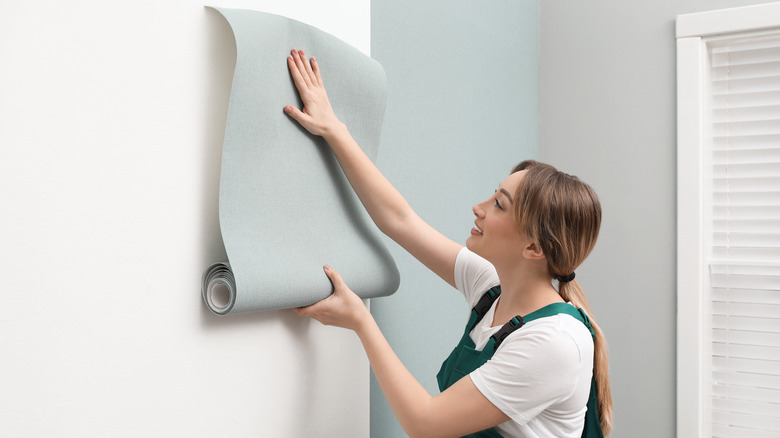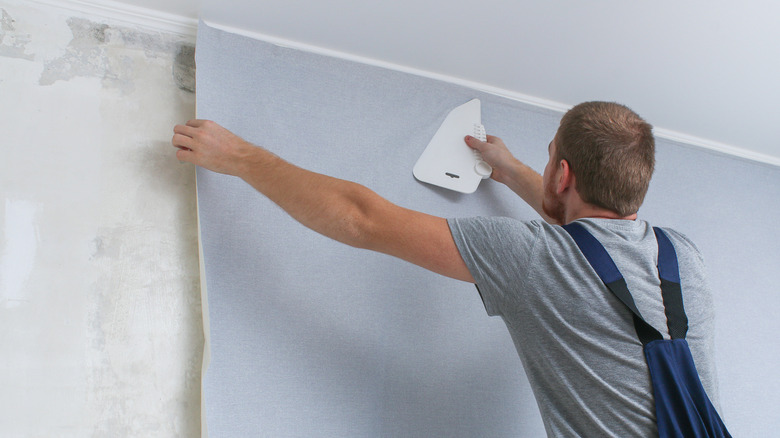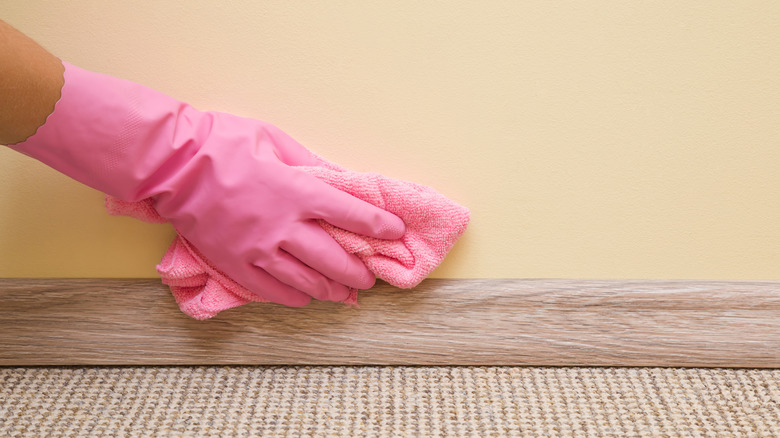The Common Application Mistake That Can Cause Your Wallpaper To Shrink
As stunning as wallpaper can look when properly applied in your space, it can also be frustrating and tricky to hang – especially if you make mistakes and don't follow instructions during the application process. In addition to the difficulties of handling wet paste while attempting to line up strips of wallpaper, many people run into major issues and frustrations when their wallpaper appears to shrink once it is fully dry, varying drastically from the way it looked while wet.
Even though your new wallpaper may look near perfect while it's still wet, once it dries, the strips may look warped and distorted, appearing to shrink and separate at the seams. This shrinkage often leads to gaps between each strip of wallpaper, revealing the wall underneath. Wet wallpaper will stretch and expand slightly during application and in the days following, but once it completely dries and returns to its permanent size, many people find that the strips that once lined up perfectly and were evenly spaced now need to be completely re-applied.
While a small amount of shrinkage is pretty much unavoidable when hanging wallpaper given the wet-to-dry nature of application, the worst of it can be prevented if you are careful not to overwork and overstretch the paper while it's wet. Properly preparing the surface of your walls prior to applying any wallpaper and ensuring the right drying conditions will also help maximize adhesion and minimize shrinkage.
Don't overstretch the wallpaper
Applying wallpaper can be tricky due to the air bubbles that tend to form after laying it in place. Although it's necessary to work out these air bubbles and any additional lumps and bumps, it's important not to stretch the wallpaper too much in the process. "Stick to the golden rule of never overworking the seams," the design team at MuralsWallpaper shared with House Beautiful. They advised against pulling on the wallpaper excessively while smoothing it out. While it may be tempting to pull the wallpaper taut to minimize air bubbles, doing so greatly increases the likelihood of it shrinking when it dries, with every tug, stretch, lift, and replication of the wallpaper.
If you find yourself having to remove or straighten a strip of wallpaper while hanging it, be cautious about lifting it up and pulling it off too many times. Overworking the wallpaper may cause it to stretch out, making it difficult to hang. If this happens, it's best to apply a fresh strip and discard the overworked piece. This prevents you from having to reapply later if the paper shrinks and leaves gaps in between the seams when dry. Buying a little extra wallpaper than what you measured for can prevent you from being tempted to lay an overworked piece.
Prep walls beforehand to guarantee maximum adhesion
Properly preparing the surface of your walls before applying wallpaper can help minimize shrinkage by ensuring the highest possible level of adhesion. If wet wallpaper is laid over grease, dirt, or any other substance on the walls, it will have a hard time gripping the surface, which can lead to increased shrinkage in certain areas of the wallpaper when everything dries.
To prepare your walls, wipe them down using a microfiber cloth and a mixture of dish soap and water to remove any grime that may interfere with the paste adhering properly. Let the wall dry completely before applying wallpaper. Laying wallpaper over a previously painted surface may also not allow for the most secure adhesion possible. To improve adhesion, gently sand the surface of the painted wall to rough up the finish. Make sure to wipe away any dust or texture from sanding prior to laying the wallpaper.
It's also important to allow the wallpaper to dry naturally to prevent shrinkage. If the room is too humid, the wallpaper won't be able to dry properly. Additionally, sources of heat like your furnace or radiator can contribute to increased shrinking by drying certain areas too quickly. To prevent this, turn off the radiator or close the air vents in the room where the wallpaper is drying. You can also open the windows to allow for natural airflow, assuming it's not overly humid outside.


